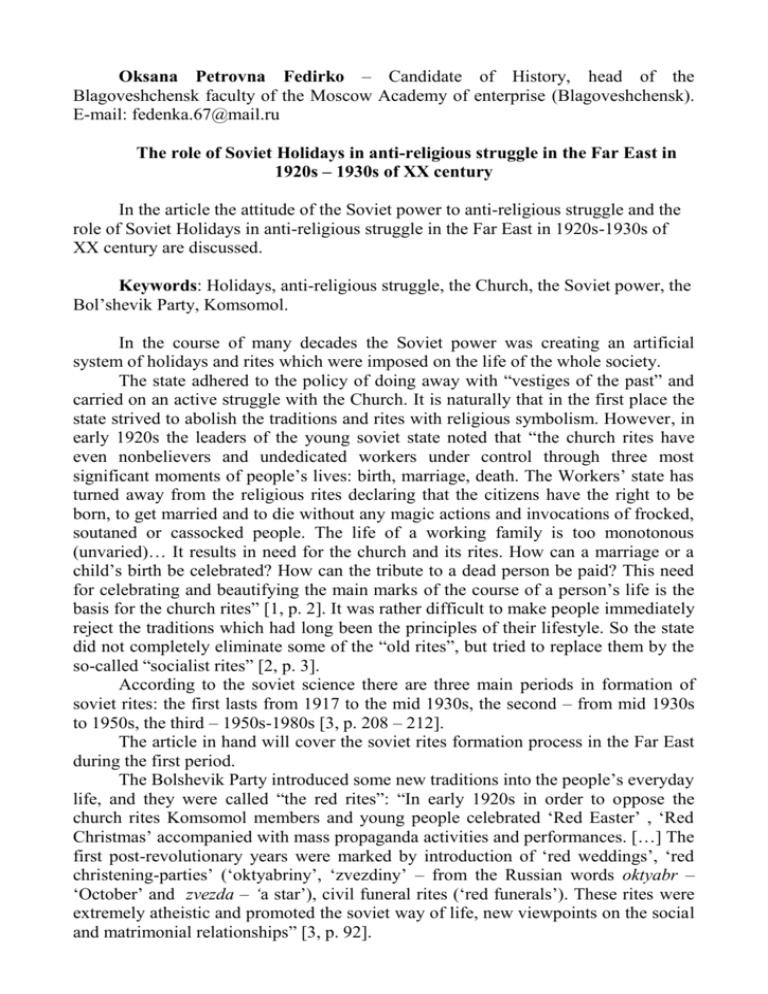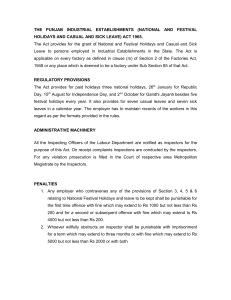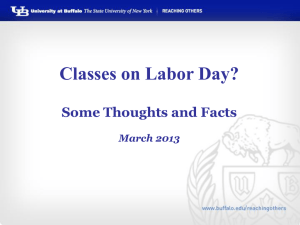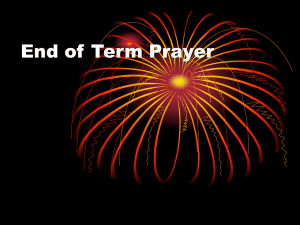downLoad
advertisement

Oksana Petrovna Fedirko – Candidate of History, head of the Blagoveshchensk faculty of the Moscow Academy of enterprise (Blagoveshchensk). E-mail: fedenka.67@mail.ru The role of Soviet Holidays in anti-religious struggle in the Far East in 1920s – 1930s of XX century In the article the attitude of the Soviet power to anti-religious struggle and the role of Soviet Holidays in anti-religious struggle in the Far East in 1920s-1930s of XX century are discussed. Keywords: Holidays, anti-religious struggle, the Church, the Soviet power, the Bol’shevik Party, Komsomol. In the course of many decades the Soviet power was creating an artificial system of holidays and rites which were imposed on the life of the whole society. The state adhered to the policy of doing away with “vestiges of the past” and carried on an active struggle with the Church. It is naturally that in the first place the state strived to abolish the traditions and rites with religious symbolism. However, in early 1920s the leaders of the young soviet state noted that “the church rites have even nonbelievers and undedicated workers under control through three most significant moments of people’s lives: birth, marriage, death. The Workers’ state has turned away from the religious rites declaring that the citizens have the right to be born, to get married and to die without any magic actions and invocations of frocked, soutaned or cassocked people. The life of a working family is too monotonous (unvaried)… It results in need for the church and its rites. How can a marriage or a child’s birth be celebrated? How can the tribute to a dead person be paid? This need for celebrating and beautifying the main marks of the course of a person’s life is the basis for the church rites” [1, p. 2]. It was rather difficult to make people immediately reject the traditions which had long been the principles of their lifestyle. So the state did not completely eliminate some of the “old rites”, but tried to replace them by the so-called “socialist rites” [2, p. 3]. According to the soviet science there are three main periods in formation of soviet rites: the first lasts from 1917 to the mid 1930s, the second – from mid 1930s to 1950s, the third – 1950s-1980s [3, p. 208 – 212]. The article in hand will cover the soviet rites formation process in the Far East during the first period. The Bolshevik Party introduced some new traditions into the people’s everyday life, and they were called “the red rites”: “In early 1920s in order to oppose the church rites Komsomol members and young people celebrated ‘Red Easter’ , ‘Red Christmas’ accompanied with mass propaganda activities and performances. […] The first post-revolutionary years were marked by introduction of ‘red weddings’, ‘red christening-parties’ (‘oktyabriny’, ‘zvezdiny’ – from the Russian words oktyabr – ‘October’ and zvezda – ‘a star’), civil funeral rites (‘red funerals’). These rites were extremely atheistic and promoted the soviet way of life, new viewpoints on the social and matrimonial relationships” [3, p. 92]. From the very beginning the government paid great attention to new revolutionary holidays. In 1918 not only November, 7, February, 23, March, 8, May, 1, which are usual to us, were declared to be state (national) holidays, but also January, 22 (in the memory of the ‘Bloody Sunday’), March, 12 (the Downfall of the Autocracy Day), January, 17 (in the memory of Carl Libknecht and Rosa Luxemburg), December, 22 (in the memory of the Moscow armed revolt), April, 16 (the Day of Lenin’s visit to Petrograd) [2, p. 20 ]. The scenarios of holidays of anti-religious nature included manifestations, meetings, mass outdoor performances, burning of crosses and God’s and priests’ effigies, etc. This was due to the fact that during the Civil War and the foreign military intervention period direct struggle with the church was regarded as a kind of struggle against the counter-revolution under the ‘mask of the church’. But the situation changed. On the one hand, the enemies (the ‘white’ and the interveners ) had been defeated and banished from the country. And on the other hand, there came the understanding that religion couldn’t be banished from people’s minds so fast [4, p. 28 – 29]. The restoration of Soviet Power in the Far East after the Civil War and the foreign military intervention started in November, 1922. Revolutionary committees (Revcoms) were established to strengthen the government’s authority, to clear the state agencies, institutions and organizations of all the ‘inimical’ elements and to enforce soviet laws. At that moment the highest body of central power in the Far East was Dalrevcom (the Far Eastern Revolutionary Committee) which was responsible to VCIC (All-Russia Central Executive Committee) and SNC (Soviet People’s Commissariat) RSFSR (Russian Soviet Federative Socialist Republic) and worked closely with the Dalbureau CC RCP(b) (Far Eastern Bureau of Central Committee of Russian Communist Party (bolshevik)). In fact Dalrevcom put the Communist Party’s and Soviet government’s decisions into life [5, p. 7 – 8]. So the Far Eastern region was under the jurisdiction of the Soviet state and its laws, which controlled all the activities (and the religious activities also) through regional and local party offices and soviet authorities. In the early years of the Soviet Power Central party and soviet bodies persistently recommended that their Far Eastern colleagues should do their best in order not to be an insult to believers’ religious feelings and to bend every effort in propaganda to the scientific explanation of religion’s origin. The period of ‘scientific’ approach to anti-religious propaganda concurred with the government policy of NEP (New Economic Policy). The Soviet political regime directed that the “assault” on religion should be made in the form of anti-religious holidays. In March, 1923 the Khabarovsk province committee of the Party received a telegram signed by V.V. Kuibishev, the secretary of the CC RCP(b). It suggested that during the Easter they should “pay the maximum attention to the propagandistic side of the antireligious campaign.” It also contained direct recommendations to prepare the appropriate literature, to publish antireligious articles in mass media and to give public lectures [6, p. 39]. The Khabarovsk province committee of the Party in its turn sent telegrams to the municipal offices of RCP(b). The telegrams provided organizing antireligious events not only on the Easter day but during other significant religious holidays: “On the Trinity Sunday, the Trinity Monday you should conduct antireligious campaigning in the city: arrange the ‘live newspaper’, give lectures, performances, ‘political trials’ on religion. Do not insult believers’ feelings. Refrain from outdoor events. Get military people involved” [7, p. 83]. Apart from that it was recommended to introduce new soviet holidays. “Organize celebrating a new revolutionary holiday – the International Youth Day on September, 2, 1923” [7, p. 157]. The Circular note of the Commission on Improving Children’s life under the Dalrevcom dated December, 11, 1923 said: “Arranging a ‘Help-the-kids’ week is the first step “on the way of changing the Christian physiognomy of December holidays”. When talking about “the Christmas holidays, their renaming and changing the Christian shade of the celebration nature nothing can be considered more effective than ‘kids’ holiday’ or ‘children’s holidays’. And there’s no other convenient pretext for changing the holiday’s nature than helping the homeless children, using such slogans as ‘Children with a home – to the homeless’, ‘Well-fed children – to hungry children’, etc. “We suggest that all the clubs should organize “Red New Year Trees (New Year celebrations)” to the benefit of homeless children. Schools, employees of different enterprises, etc. should involve as many children as possible, so that they were accompanied by their mothers and relatives. This would attain two goals: distracting parents and children from the traditional celebrations and helping the needy children” [8, p. 32 – 32]. It’s well-known fact that on December, 26, 1923 members of Petropavlovsk gorraicom (city district committee) of Russia Communist Youth Union celebrated ‘Komsomol Christmas’ [9, p. 76]. The soviet government tried to introduce some holidays specially for peasants. So in 1923 Krupskaya N. K. published an article “The Harvest Holiday” in “Pravda” newspaper. This article suggested “developing the old traditions on the new base”. According to the government idea “the harvest day was to continue the old traditions and customs accompanying summer and spring harvest jobs” [2, p. 42]. At first, authorities decided to waive the principles – for the first years the Harvest Day was timed to Christian holiday “Spas Transfiguration” (widely known as Apple Spas”. Further this holiday was celebrated at different placed different times [2, p. 42]. The documents of 1924 reflect the “whole picture of the harsh and tactless critiques of the religion”. The meeting of the most active participants of the “Komsomol Easter” took place on the 20th of March. On the 8th of April the rules for Komsomol Easter celebration were approved by the gorkom (City Committee): 24 th of April - political trial on the religion; 26th of April – the solemn meeting in honor of “Gods Deposition”... speeches of Domman – “The science and religion are incompatible”; Odliynitskiy – “The Christian and Jewish Easter celebration” and so on. Seven speeches were planned including “The Myth about Christ”, “In the hands of bourgeoisie religion turns into the weapon of exploitation”. The plan was full fielded as follows. In the middle of the month it was announced that “Priest Leontiy” (Leontiy Yakovlev, the abbot of the Petropavlovsk Cathedral) was invited for the political trial as a defendant. From the diary of the Komsomol organization secretary (school of the second stage): “on the 19 th of the April the Sorapros organization made a Virgin Marry effigy. On April, 24 at 6 p.m. komsomol members went to the public theater where religion trial took place. Many people presented at this event. People left disappointed as if they were waiting for something different” [9. L. 76]. The secretary of Kamtchatsk Province Bureau of the Russian Communist Youth Union I. Mlkov wrote in the secret report: “The Komsomol Easter caused a sensation (burning of the priest’s effigy near the church, singing religious songs during the service and so on). But the content of the whole ceremony was very poor and harmful. Such way of anti-religious campaign only embittered the believed Kamchadals [9. L. 83]. Sometimes in order to distract the people’s attention from the religious holidays, less active methods were also used. Petropavlovskaya school of the second stage has informed its authorities in 1924: “…on the 27 th of April on Sunday (it was Easter) pupils were busy with preparation and organization of the 1 st May celebration…” [10. L. 77]. Regulations ordered that the school should take an active part in anti-religious propaganda. And this work was actively carried out among pupils and society. Advertising anti-religious holidays, the Meeting of the Kamtchatsk union of the workers of education on 24th of April 1924 passed the following resolution: “Religion is the opium for our society. Religion is the right hand of the bourgeoisie and its impudent exploitation of the working people. The bourgeoisie used holidays given to the working people in its personal interests. During these religious holidays the priests and all church brotherhood carried out their religious campaign. And instead of having a rest after long and hard work people were invited to the stuff church. The slave submissiveness and humility to the God and authorities of the bourgeoisie were knocked into their heads. And tired and obedient people carried this hard burden. We, free workers of Kamchatka, educators, are acknowledged that only light and knowledge not the church with its unnecessary holidays and traditions will give us perspective future. We announce that tomorrow Eater will be our ordinary working day. We call workers of the whole world to end up with this religious narcotic. Vita the science! Get rid of religion and all its holidays, customs and traditions! The released proletariat would be able to celebrate only anti-religious holidays, anniversaries of their struggles and victories” [10. L. 16]. As an example of the significant anti-religious event can be considered the celebration of anti-religious Easter on the 4th of April. The action took place in theater of the Party Professional club named after Noriman-Norimanova in Petropavlovsk. The content of the meeting was as follows: 1. The report on the topic “The importance of the Komsomol Easter”. 2. The anti-religious one act comedy “The key to solving”. 3. The first part of the divertissement, choral and musical performances. 4. Anti-religious stories, fables and anecdotes. 5. “Easter misunderstanding” – the one act anti-religious comedy. 6. The second part of the divertissement, anti-religious ditties, declamations and sport numbers [11, 28]. The contents of the comedies were rather rude. In “Easter misunderstanding” the orthodox Christians were introduced by the Kulak (wealthy peasant) with his beliefs that “without the church a person can not commit a sin and can not confess”. His wife agreed with him: “You are absolutely right, my father! The whole year I have been sinning. And now my sole is as clean and pure as if I am an infant.” The komsomol chorus sang the song on the tune of “The Overcoat” Without unnecessary talk Without unnecessary words We’ll throw away all the Saint Gods to the bin. In the play the working people were presented by a man and a woman and they proved it with the ditties: HE I won’t go to church any more The fairy tale is rather old You won’t catch the proletariat any more. SHE There is another word We struggle the whole life I don’t want to read theology I want to read Lenin’s works It was the end of “Easter misunderstanding” [11. L. 29 – 30]. Of particular interest are the notes from the report of Petropavlovsk Komsomol organization about this event: “Komsomol members did not drink alcohol systematically but sometimes they did but not too much. Such occasions took place during anti-religious Easter” [9. L 76 – 77]. The youth was also widely involved into these anti-Easter and anti-Christmas actions. The party recommended komsomol organizations different forms and methods for conducting anti-religious campaigns. These recommendations were a guide for action for the komsomol organization. At the meeting of the Far East Komsomol Committee Secretariat in April 1927 the Far East Bureau recommended to pay attention to the following during Easter celebration: a) cultural mass work: to organize the youth leisure through youth clubs and reading rooms in order to distract their attention from negative behavior; b) press: to create public opinion about anti-religious propaganda and movement through komsomol publishing houses and wall newspapers [12. L. 87]. Special literature collections were published within anti-Easter campaign. They contained directive articles about social importance of the Easter and its campaign, programs and materials for anti-religious concerts, “live newspapers” (poems, plays), report thesis for lecturers. On the 7th of July the territory Committee passed a resolution “About antireligious work in the region” which said: “Our region is characterized by increasing activity of religious organizations. It is expressed by their inner activity and constant attempts to develop their influence on the peasantry and to improve the resource base of religious organizations” [13, p. 9]. Due to propaganda many people, the whole villages, refused from celebrating religious holidays. In 1927 in the Far East 113 villages refused from them, and in 1928 – 341. In 1928 People's Commissariat of Education of RSFSR joined the process of strategy development of antireligious holidays. The Central Cabinet of Education sent the materials on anti-Christmas campaign. The general statement of anti-Christmas campaign contained contraposition of the meaning of two holidays for workers: decennial event of October Revolution and Christmas. The anti-Christmas campaign was supposed to be attuned with important facts of international situation of USSR, if to be more exact, with efforts of international bourgeoisie to start a war against USSR to delete the power of workers. “We should speak about the fact that with prayers and religious songs we won’t defend ourselves from the attack of the world capital. We should consolidate the defense of USSR by strengthening our aviation by collecting money for squadron “Our reply to Chamberlain”, for the aircraft “Atheist”. The most acceptable ways of anti-Christmas campaign were sport activities. “Anti-religious skating, skiing – all these can grab youth’s attention from the church, sectarian preaches and holiday hooliganism”. The following programme of an anti-religious party was recommended: 1. a short report; 2. a short play; 3. declamation of poetry; 4. performances of the socalled “live newspaper”; 5. chorus singing. The repertoire of the plays was the following: 1. “The holy devil” by Skvortsov (“Atheist” publish house). 2. “According to gospel” by Gradov (“Atheist” publish house). 3. “A funny play about Aksinia”. 4. “A Komsomolskaya easter” (“Krasnaya nov” publish house). 5. “Anti-religious evenings”, “The holy inquisition” by Federov and so on. To strengthen the effect of these activities it was supposed to design a stand or a poster dedicated to the anti-Christmas campaign. It was necessary to show how October Revolution enabled releasing workers from the burden of religion, to show what damage religion causes and Christmas in particular. However anti-religious holidays were celebrated only by members of komsomol and members of Russian Communist Party (b), the rest population went on celebrating religious holidays and didn’t go to work during these days. In order to resolve this problem religious holidays were replaced by holidays of labour. In 1929 in the Far East the holiday “The first day of industrialization” was celebrated instead of the holiday of the Transfiguration and “The second day of industrialization” instead of Christmas. During these days all working people went to work, and there were no drunk people [16, c. 14]. The government would follow this tactics in an anti-religious propaganda up to 1950s of the 20th century. Using such propagandistic means like anti-religious holidays in the struggle with religion, soviet ideologists tried to adjust new rites. The scenarios of celebrating anti-religious holidays, being sometimes very rough in form and provocative, reached their target. In 1920s and 1930s a religious ideology was replaced by a soviet ideology not only but also due to anti-religious holidays. Literature and the sources: 1. L.D. Trotskiy. The culture of transitional period: family and rites // Pravda. – 1923. – № 156. 2. L.A. Tooltseva. Modern holidays and rites of USSR people. – M., 1985. 3. A.V. Kurochkin. The periods of forming of soviet rites/ Soviet traditions, holidays and rites. – Kiev, 1988. 4. G. V. Vorontsov. Mass atheism: formation and development. – L. 1983. 5. Local Soviets of Primor’ye. History Pages. 6. State Archive of Khabarovsk Region (SAKhR). – F.P-318. – Op. 1. – D. 3. 7. State Archive of Khabarovsk Region (SAKhR). – F.P-318. – Op. 1. – D. 33. 8. State Archive of Kamchatsk Region (SAKR). – F.P-19. – Op. 1. – D. 19. 9. State Archive of Kamchatsk Region (SAKR). – F.P-53. – Op. 1. – D. 40. 10. State Archive of Kamchatsk Region (SAKR). – F.P-19. – Op. 6. – D. 143. 11. State Archive of Kamchatsk Region (SAKR). – F.P-326. – Op. 1. – D. 23. 12. State Archive of Khabarovsk Region (SAKhR). – F.P-618. – Op. 1. – D. 18. 13. Izvestia of the Far-Eastern Territorial Committee 1928. – №13-14. June 20. 14. State Archive of Sakhalin (SAS). – F. 1174. – Op. 2. – D. 80. 15. State Archive of Kamchatsk Region (SAKR). – F.P-37. – Op. 1. – D. 4. 16. I. Uskov. Against religion, for atheism. – Vladivostok, 1930.







